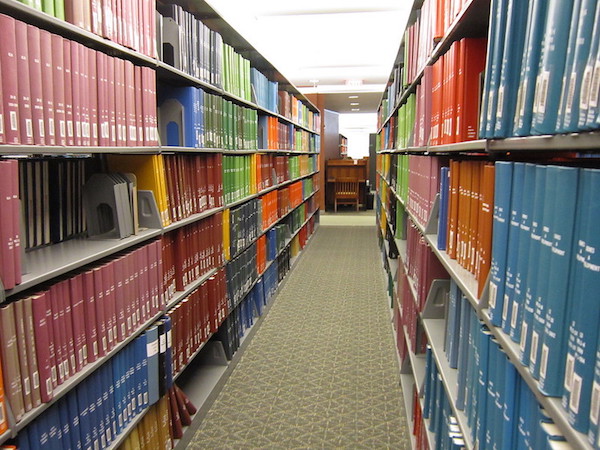SEJournal Online is the digital news magazine of the Society of Environmental Journalists. Learn more about SEJournal Online, including submission, subscription and advertising information.
 |
| Indexes to scientific journals can be a useful shortcut to identifying potential stories, finding abstracts and, in some cases, finding ways to access costly publications for free. Above, stacks at the University of North Carolina Health Science Library. Photo: Selena N. B. H. via Flickr Creative Commons (CC BY 2.0). |
Reporter’s Toolbox: Publication Indexes — Roadmaps to Environmental Science Journals … and News
By Joseph A. Davis
It happens regularly — some prominent science journal publishes an article about an environmental question, some major media science writer sees it and — boom! — it’s news.
It’s a reminder that science journals can be a reporter’s friend (however hard they may sometimes be to understand). And there are many reasons why environmental journalists, in particular, might want to be poking into them.
Ah! you say: I don’t have the time or money to go digging through the university libraries where most of those journals live.
Never fear. Toolbox has a few tips.
Get ‘index’ savvy
First, find the indexes of scientific journals. Most at least show a path toward getting the text of the article — whether it costs money or not. Many include at least abstracts that will help you gauge whether the article is relevant or useful.
It’s true that not all of the indexes are affordable, available or free to journalists. If you’re part of a news organization, you may find indexes and other resources if your publication has a fact-checking or research department.
Through libraries, you’ll find that
many of the indexes, and even the journal
articles themselves, may be available free.
And through libraries, you’ll find that many of the indexes, and even the journal articles themselves, may be available free.
So try being a patron of a library, whether by paying a pittance for a municipal library card or by working out a deal with a big research library (you may be able to get temporary library privileges as a graduate or if you tell them you’re doing a research project).
Useful indexes to try
- Google Scholar: If you have a Google account, you are already a member. This tool has the thunderous power of Google behind it — and tries very hard to help you. When the article can be read for free, it guides you to the text. There are pros and cons (more on that). Bottom line: It is not exhaustive and you can’t narrow it down by subject.
- EBSCO: This index to scholarly publications is widely used in libraries (municipal and other). The way to access it is through libraries. If you have a library card, you may be able to access it online. If there is an online text available for free, it will guide you to that.
- NIEHS: The National Institute of Environmental Health Sciences gathers its databases on research in its general sub-area (toxicity, etc.). Its journal, Environmental Health Perspectives, is important and free.
- Agricultural & Environmental Science Database: This research tool from the University of Wisconsin-Madison offers cross-disciplinary journals, trade publications, conference proceedings and more for agriculture and environmental sciences research.
- NOAA Central Library: The National Oceanic and Atmospheric Administration has facilities all over the United States. But if you are in the Washington, D.C., metro area, you can walk right in. It has more than 4,000 journals in its subject areas — especially climate, oceanography and fisheries. Its materials may also be available via interlibrary loan.
- Web of Science: This major research index is especially good with citation format and data on how often an article is cited in other articles. It includes both free and paid versions.
- PubMed Central: This online index is maintained by the National Library of Medicine, which is open if you are in Washington, D.C., and has every medical journal you can imagine. The index favors free articles and it guides you to them when it can.
- Society of Environmental Journalists: Members of SEJ can also access discounts on a variety of scientific journal-related resources, as well as embargoed alerts. ">
Some pro tips
- Many smart and experienced science journalists know that some journals are more likely to make news. They may come out weekly or monthly — and a few even have a daily news bulletin online. Typically, this list includes pubs like Science, Nature, Lancet, etc. The pros know what day they come out and check them.
- Check whether the article has been peer-reviewed. This can be tricky terrain. Even good journals may report on “pre-prints” of articles before they have been fully peer-reviewed.
- Beware of publication by press release or press conference. The illusion of speed may distort the perception of newsiness.
- Ask whether the study has been replicated. Look at more than one study.
- Seek comment from experts in the field who are not among an article’s authors.
- If the authors use the word “breakthrough,” be doubly skeptical. Other words to worry about: discovery, innovation, solution, first, doomsday, … well, you get the idea.
Joseph A. Davis is a freelance writer/editor in Washington, D.C. who has been writing about the environment since 1976. He writes SEJournal Online's TipSheet, Reporter's Toolbox and Issue Backgrounder, and curates SEJ's weekday news headlines service EJToday and @EJTodayNews. Davis also directs SEJ's Freedom of Information Project and writes the WatchDog opinion column.
* From the weekly news magazine SEJournal Online, Vol. 8, No. 4. Content from each new issue of SEJournal Online is available to the public via the SEJournal Online main page. Subscribe to the e-newsletter here. And see past issues of the SEJournal archived here.














 Advertisement
Advertisement 



